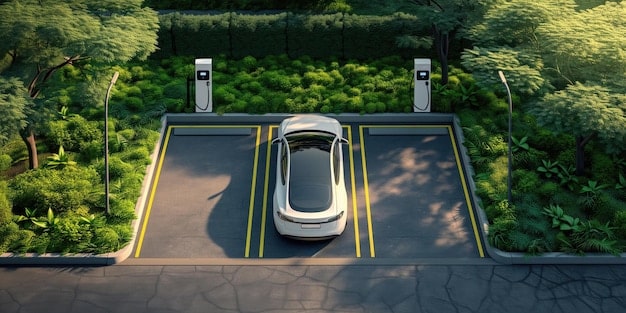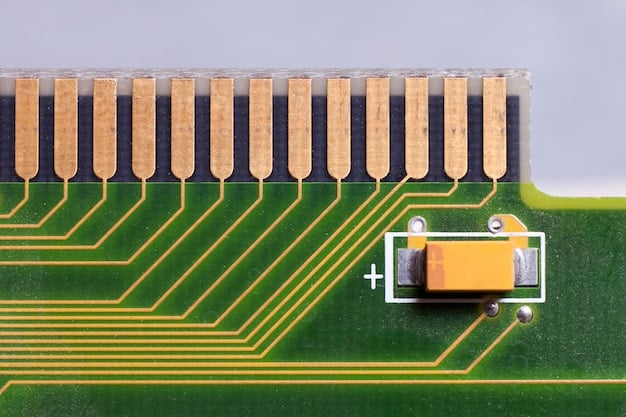Electric Vehicle Battery Recycling: Automakers’ Strategies in the US

US automakers are addressing electric vehicle (EV) battery recycling challenges through initiatives like developing efficient recycling processes, establishing partnerships with recycling companies, and investing in research for sustainable battery materials and designs.
The surge in electric vehicle (EV) adoption across the US has brought the critical issue of battery recycling into sharp focus. How are automakers addressing the challenges of electric vehicle battery recycling in the US? Let’s delve into the strategies they’re employing to create a sustainable future for EV batteries.
The Growing Urgency of EV Battery Recycling
As electric vehicles become more prevalent on American roads, the question of what happens to their batteries at the end of their lifespan becomes increasingly important. The environmental and economic implications of improper disposal are significant, making recycling a crucial component of a sustainable EV ecosystem.
EV batteries contain valuable materials such as lithium, cobalt, and nickel. Recycling these materials not only reduces the need for virgin mining but also minimizes the environmental impact associated with battery production. Automakers are now recognizing the importance of this and are taking proactive steps.

Environmental Concerns and Resource Recovery
The improper disposal of EV batteries poses several environmental risks, including soil and water contamination. Recycling ensures that these hazardous materials are handled safely and responsibly.
Recovering valuable materials from spent batteries also reduces reliance on global supply chains, promoting energy independence and economic stability. Automakers are exploring innovative recycling technologies to maximize resource recovery.
- Sustainable Material Sourcing: Automakers are focusing on sourcing materials responsibly and advocating for ethical mining practices for battery components.
- Reducing Landfill Waste: Recycling prevents batteries from ending up in landfills, where they can leach harmful substances into the environment.
- Circular Economy Initiatives: Companies are embracing circular economy models that prioritize reuse, refurbishment, and recycling to minimize waste and maximize resource utilization.
- Lowering Carbon Footprint: Recycling reduces the carbon footprint associated with producing new batteries, contributing to a more sustainable lifecycle for EVs.
In conclusion, addressing the urgency of EV battery recycling involves both environmental stewardship and economic opportunity. By focusing on responsible disposal and resource recovery, automakers can drive the industry towards a more sustainable future.
Automakers’ Recycling Initiatives and Partnerships
Many automakers are launching their own recycling programs and forming strategic partnerships to address the challenges of EV battery recycling. These initiatives range from developing proprietary recycling technologies to collaborating with specialized recycling companies.
These partnerships leverage the expertise of recycling companies to ensure that batteries are processed efficiently and safely. Automakers are also researching ways to optimize battery design to facilitate easier recycling.
Proprietary Recycling Technologies
Some automakers are investing in developing their own recycling technologies to gain greater control over the process and maximize material recovery.
These technologies often involve advanced processes such as hydrometallurgy and pyrometallurgy, which can extract valuable materials with high efficiency.
- BMW’s Recycling Program: BMW has launched a recycling program that aims to recover valuable materials from EV batteries, reducing waste and promoting sustainability.
- GM’s Collaboration with Redwood Materials: General Motors is working with Redwood Materials to recycle battery materials and create a closed-loop system for EV batteries.
- Ford’s Battery Refurbishment Efforts: Ford is exploring battery refurbishment options to extend the lifespan of EV batteries and reduce the need for new materials.
- Volkswagen’s Pilot Recycling Plant: Volkswagen has established a pilot recycling plant in Germany to test and refine EV battery recycling processes.
In summary, automakers are actively pursuing recycling initiatives and partnerships to handle the growing volume of EV batteries reaching the end of their life. These efforts are crucial for creating a sustainable and circular EV ecosystem.
Technological Innovations in Battery Recycling
Technological advancements are revolutionizing the EV battery recycling landscape. Innovations in sorting, disassembly, and materials extraction are making the process more efficient and cost-effective.
These advancements not only improve the economics of recycling but also reduce the environmental impact, making it a more attractive option for automakers and consumers alike.

Advanced Sorting and Disassembly
Efficient sorting and disassembly are critical first steps in the recycling process. Advanced technologies like AI-powered robots are being used to automate these tasks.
These robots can quickly identify and separate different battery components, streamlining the recycling process and reducing labor costs.
- Automated Disassembly Systems: Companies are developing automated systems that can safely and efficiently disassemble EV batteries.
- AI-Driven Sorting Technologies: Artificial intelligence is used to identify and sort different battery chemistries, optimizing the recycling process.
- Improved Material Extraction Techniques: Innovations in material extraction technologies are increasing the recovery rates of valuable metals like lithium and cobalt.
- Hydrometallurgical Processes: Hydrometallurgy involves using chemical solutions to dissolve and extract valuable materials from battery components.
To conclude, technological innovations are transforming EV battery recycling, making it more efficient, cost-effective, and environmentally friendly. These advancements are enabling automakers to achieve higher recycling rates and reduce their reliance on virgin materials.
The Role of Government Regulations and Incentives
Government regulations and incentives play a crucial role in promoting EV battery recycling. Policies that mandate recycling targets and provide financial incentives can encourage automakers and recycling companies to invest in sustainable practices.
These regulations also ensure that batteries are handled safely and responsibly, minimizing the environmental impact of disposal.
Federal and State Policies
Both federal and state governments are implementing policies to support EV battery recycling. These policies often include recycling mandates, tax credits, and grants for research and development.
These incentives help to level the playing field and make recycling more economically viable.
- Recycling Mandates: Some states are considering recycling mandates that would require automakers to recycle a certain percentage of their EV batteries.
- Tax Credits for Recycling Companies: Tax credits can incentivize recycling companies to invest in advanced recycling technologies and expand their operations.
- Grants for Research and Development: Government grants can support research into innovative recycling processes and sustainable battery materials.
- Extended Producer Responsibility (EPR): EPR policies hold automakers responsible for the end-of-life management of their batteries.
In summary, government regulations and incentives are essential for driving the adoption of EV battery recycling. By creating a supportive policy environment, governments can encourage automakers and recycling companies to invest in sustainable practices.
Challenges and Obstacles in EV Battery Recycling
Despite the progress being made, several challenges and obstacles still hinder the widespread adoption of EV battery recycling. These include the high cost of recycling, the lack of standardized recycling processes, and the logistical complexities of collecting and transporting spent batteries.
Addressing these challenges will require collaborative efforts from automakers, recycling companies, governments, and consumers.
Cost and Logistical Issues
The high cost of recycling can make it less economically attractive compared to producing new batteries. Logistical challenges such as collecting and transporting batteries from various locations also add to the complexity.
These challenges need to be overcome to create a viable and sustainable recycling industry.
- High Recycling Costs: The cost of recycling can be prohibitive, especially for smaller recycling companies.
- Lack of Standardized Processes: The lack of standardized recycling processes can lead to inefficiencies and inconsistencies in material recovery.
- Transportation and Collection Logistics: Collecting and transporting spent batteries from various locations can be logistically complex and expensive.
- Battery Chemistry Variations: The diverse chemistry of EV batteries means recycling processes need to be adapted, increasing complexity.
In conclusion, while EV battery recycling is gaining momentum, significant challenges remain. Addressing these issues through innovation, standardization, and collaboration will be crucial for realizing its full potential.
The Future of Sustainable EV Battery Management
The future of sustainable EV battery management involves a holistic approach that encompasses design, reuse, refurbishment, and recycling. Automakers are increasingly focusing on designing batteries that are easier to recycle and exploring options for second-life applications.
These efforts will help to create a circular economy for EV batteries, reducing waste and maximizing resource utilization.
Design for Recycling and Second-Life Applications
Designing batteries with recycling in mind can significantly reduce the cost and complexity of the process. Second-life applications, such as using EV batteries for energy storage, can also extend their useful life.
These strategies are essential for creating a sustainable future for EV batteries.
- Modular Battery Designs: Modular designs make it easier to disassemble and recycle battery components.
- Second-Life Energy Storage Systems: Repurposing EV batteries for energy storage can extend their lifespan and reduce waste.
- Sustainable Battery Materials: Research into sustainable battery materials can reduce the environmental impact of battery production.
- Closed-Loop Recycling Systems: Closed-loop systems ensure that materials recovered from recycling are used to produce new batteries.
To conclude, the future of EV battery management hinges on innovation and collaboration. By focusing on design for recycling, second-life applications, and sustainable material sourcing, automakers can create a circular and sustainable EV ecosystem.
| Key Point | Brief Description |
|---|---|
| 🌱 Recycling Urgency | The need for EV battery recycling is growing due to increased EV adoption and environmental concerns. |
| 🤝 Partnerships | Automakers form partnerships with specialized companies to improve battery recycling processes. |
| ⚙️ Technological Innovations | Advancements such as AI and automation are making recycling more efficient. |
| 📜 Government Role | Regulations and incentives drive investment in sustainable recycling practices. |
FAQ
▼
EV battery recycling is crucial for reducing environmental impact by preventing hazardous materials from landfills and recovering valuable resources like lithium, cobalt, and nickel.
▼
Automakers are investing in recycling technologies, establishing partnerships with recycling firms, and researching battery designs that facilitate easier and more efficient recycling processes.
▼
Key challenges include the high cost of recycling, the lack of standardized recycling processes, logistical complexities in collecting spent batteries, and variations in battery chemistry.
▼
Government regulations, such as recycling mandates and tax credits, incentivize automakers and recycling companies to invest in sustainable practices and ensure the safe handling of batteries.
▼
The future involves designing batteries for easier recycling, exploring second-life applications like energy storage, using sustainable materials, and establishing closed-loop recycling systems to maximize resource utilization.
Conclusion
In conclusion, the strategies employed by automakers to tackle electric vehicle battery recycling in the US are varied and evolving. From establishing key partnerships to investing in innovative technologies, the industry is acknowledging the critical importance of sustainable battery management. While challenges remain, the ongoing efforts to improve recycling processes and government support point towards a future where EV batteries are managed responsibly, contributing to a more sustainable automotive ecosystem.





